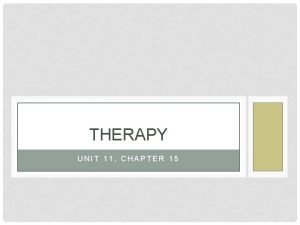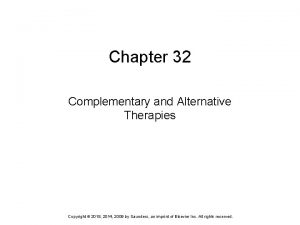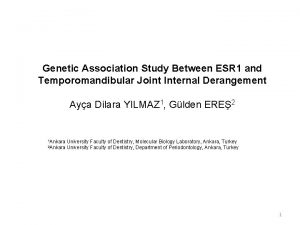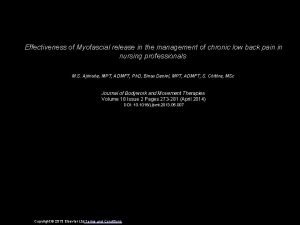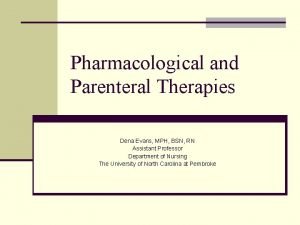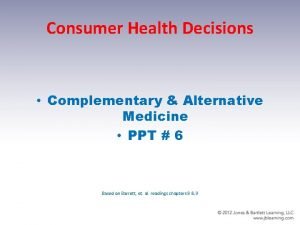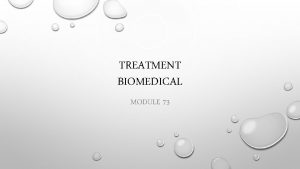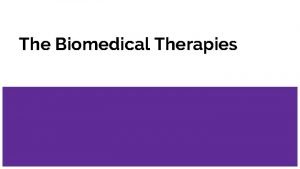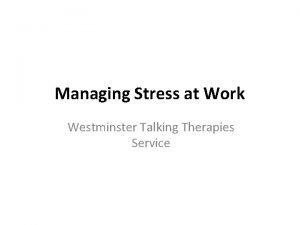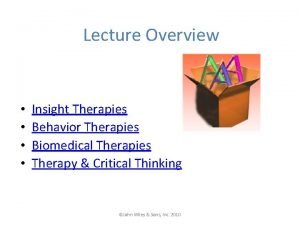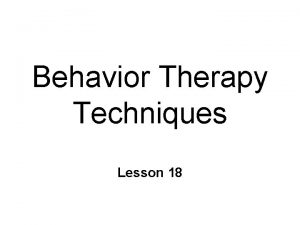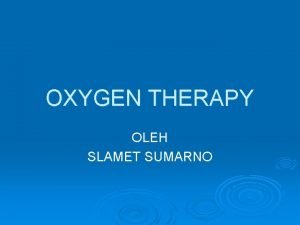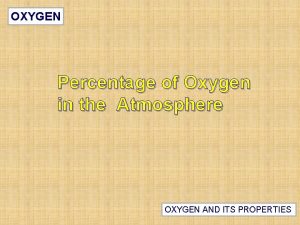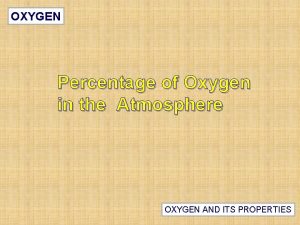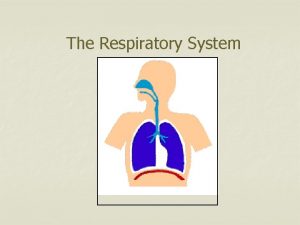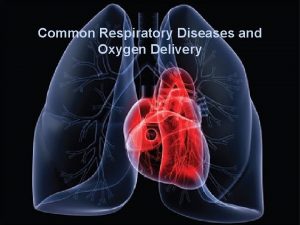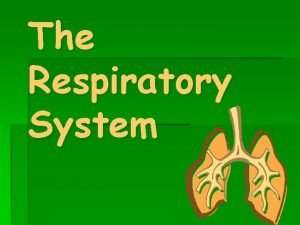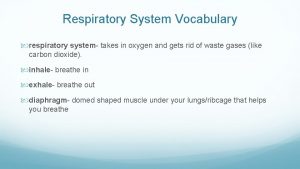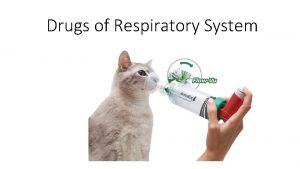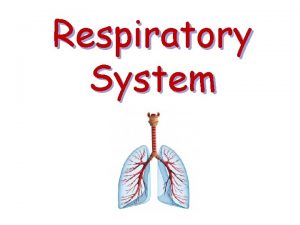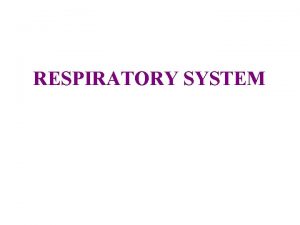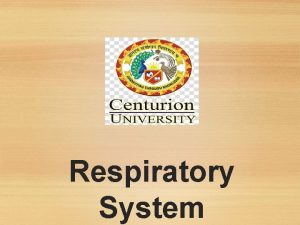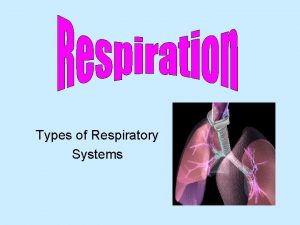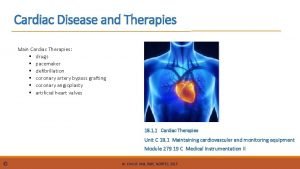Chapter 25 Oxygen Needs and Respiratory Therapies All
























- Slides: 24

Chapter 25 Oxygen Needs and Respiratory Therapies All items and derived items © 2015, 2011 by Mosby, Inc. , an imprint of Elsevier Inc. All rights reserved.

Oxygen (O 2) is a gas. It has no taste, odor, or color. Ø It is a basic need required for life. Ø Death occurs within minutes if breathing stops. Brain damage and serious illness can occur without enough oxygen. All items and derived items © 2015, 2011 by Mosby, Inc. , an imprint of Elsevier Inc. All rights reserved. 2

Factors Affecting Oxygen Needs Altered function of any system affects oxygen needs. Ø Oxygen needs are affected by: • Respiratory system status • Circulatory system function • Red blood cell (RBC) count • Nervous system function • Aging • Exercise All items and derived items © 2015, 2011 by Mosby, Inc. , an imprint of Elsevier Inc. All rights reserved. 3

Factors Affecting Oxygen Needs (Cont’d) Fever Ø Pain Ø Drugs (respiratory depression, respiratory arrest) Ø Smoking Ø Allergies—bronchitis and asthma are risks Ø Pollutant exposure Ø Nutrition—vitamins and iron are needed to produce RBCs Ø Alcohol—depresses the brain Ø All items and derived items © 2015, 2011 by Mosby, Inc. , an imprint of Elsevier Inc. All rights reserved. 4

Altered Respiratory Function Respiratory function involves three processes. Air moves into and out of the lungs. Ø O 2 and carbon dioxide (CO 2) are exchanged at the alveoli. Ø The blood carries O 2 to the cells and removes CO 2 from them. Ø Hypoxia means that cells do not have enough oxygen. Anything that affects respiratory function cause hypoxia. Ø The brain is very sensitive to inadequate O 2. Ø Hypoxia is life threatening. Ø All items and derived items © 2015, 2011 by Mosby, Inc. , an imprint of Elsevier Inc. All rights reserved. 5

Abnormal Respirations Adults normally have 12 to 20 respirations per minute. Ø They are quiet, effortless, and regular. Ø Both sides of the chest rise and fall equally. Tachypnea is rapid breathing. Ø Respirations are 20 or more per minute. Hypoxemia is a reduced amount of oxygen in the blood. Bradypnea is slow breathing. Ø Respirations are fewer than 12 per minute. Apnea is the lack or absence of breathing. Hypoventilation means respirations are slow, shallow, and sometimes irregular. Hyperventilation means respirations are rapid and deeper than normal. All items and derived items © 2015, 2011 by Mosby, Inc. , an imprint of Elsevier Inc. All rights reserved. 6

Abnormal Breathing Patterns Dyspnea is difficult, labored, or painful breathing. With Cheyne-Stokes respirations: Respirations gradually increase in rate and depth. Ø Then they become shallow and slow. Ø Breathing may stop (apnea) for 10 to 20 seconds. Ø Orthopnea means breathing deeply and comfortably only when sitting. Biot’s respirations are rapid and deep respirations followed by 10 to 30 seconds of apnea. Kussmaul respirations are very deep and rapid respirations. All items and derived items © 2015, 2011 by Mosby, Inc. , an imprint of Elsevier Inc. All rights reserved. 7

Assisting with Assessment and Diagnostic Tests Altered respiratory function may be an acute or chronic problem. The doctor orders tests to find the cause of the problem. Ø Chest x-ray (CXR) Ø Lung scan Ø Bronchoscopy Ø Thoracentesis Ø Pulmonary function tests Ø Arterial blood gases (ABGs) Ø Sputum specimens All items and derived items © 2015, 2011 by Mosby, Inc. , an imprint of Elsevier Inc. All rights reserved. 8

Pulse Oximetry Pulse oximetry measures the oxygen concentration in arterial blood. The normal range is 95% to 100%. Ø A sensor attaches to a finger, toe, earlobe, nose, or forehead. Ø An alarm sounds if: Ø • O 2 concentration is low. • The pulse is too fast or slow. • Other problems occur. A good sensor site is needed. Ø Use Sp. O 2 when recording the oxygen concentration value: Ø • S = saturation • p = pulse • O 2 = oxygen All items and derived items © 2015, 2011 by Mosby, Inc. , an imprint of Elsevier Inc. All rights reserved. 9

Promoting Oxygenation To get enough oxygen, air must move deep into the lungs. Ø Air must reach the alveoli, where O 2 and CO 2 are exchanged. Measures to meet oxygen needs are found in care plans. Positioning Ø Breathing is usually easier in semi-Fowler’s and Fowler’s positions. Ø Persons with difficulty breathing often prefer the orthopneic position. Ø Frequent position changes are needed. All items and derived items © 2015, 2011 by Mosby, Inc. , an imprint of Elsevier Inc. All rights reserved. 10

Respiratory Support Deep breathing and coughing Deep breathing moves air into most parts of the lungs. Ø Coughing removes mucus. Ø Deep-breathing and coughing exercises promote oxygenation and: • Help persons with respiratory problems • Are done after surgery and during bedrest • Help prevent pneumonia and atelectasis Ø The goal of incentive spirometry is to improve lung function. Ø Atelectasis is prevented or treated. All items and derived items © 2015, 2011 by Mosby, Inc. , an imprint of Elsevier Inc. All rights reserved. 11

Assisting with Oxygen Therapy Oxygen is treated as a drug. The doctor orders: The amount of oxygen to give Ø The device to use Ø When to give it Ø The person may need: Oxygen constantly Ø Oxygen for symptom relief Ø All items and derived items © 2015, 2011 by Mosby, Inc. , an imprint of Elsevier Inc. All rights reserved. 12

Oxygen Therapy You do not give oxygen. Ø Oxygen is supplied as follows: Ø Ø You assist the nurse in providing safe care. Wall outlet Oxygen tank Oxygen concentrator Liquid oxygen system Common oxygen devices include: Ø Ø Ø Nasal cannula Simple face mask Partial-rebreather mask Non-rebreather mask Venturi mask All items and derived items © 2015, 2011 by Mosby, Inc. , an imprint of Elsevier Inc. All rights reserved. 13

Oxygen Therapy (Cont’d) Talking and eating are hard to do with a mask. Moisture can build up under the mask. Ø Ø Keep the face clean and dry. Masks are removed for eating. The oxygen flow rate Ø The flow rate is the amount of oxygen given. Ø When giving care and checking the person: Ø Know your center’s policy about nursing assistants adjusting oxygen flow rates. • It is measured in liters per minute (L/min). • The nurse or respiratory therapist sets the flow rate. • Always check the flow rate. • Tell the nurse at once if it is too high or too low. All items and derived items © 2015, 2011 by Mosby, Inc. , an imprint of Elsevier Inc. All rights reserved. 14

Oxygen Therapy (Cont’d) Oxygen administration set-up If not humidified, oxygen dries the airway’s mucous membranes. Ø Distilled water is added to the humidifier. Ø Bubbling in the humidifier means that water vapor is being produced. Ø You assist the nurse with oxygen therapy. You do not give oxygen. Ø You do not adjust the flow rate unless allowed by your state and center. Ø All items and derived items © 2015, 2011 by Mosby, Inc. , an imprint of Elsevier Inc. All rights reserved. 15

Assisting with Respiratory Therapy Some persons need inhalers, nebulizer treatments, artificial airways, suctioning, mechanical ventilation, and chest tubes. The goals for respiratory rehabilitation are to help the person: Ø Reach his or her highest level of function Ø Live as independently as possible Ø Return home Artificial airways keep the airway patent (open). Ø Intubation means inserting an artificial airway. All items and derived items © 2015, 2011 by Mosby, Inc. , an imprint of Elsevier Inc. All rights reserved. 16

Intubation means inserting an artificial airway. These airways are common: Oropharyngeal airway Ø Endotracheal (ET) tube Ø Tracheostomy tube Ø All items and derived items © 2015, 2011 by Mosby, Inc. , an imprint of Elsevier Inc. All rights reserved. 17

Artificial Airway Care for persons with artificial airways Vital signs are checked often. Observe for hypoxia and other signs and symptoms. Ø If an airway comes out or is dislodged, tell the nurse at once. Ø Frequent oral hygiene is needed. Ø Follow the care plan. Ø Ø Persons with ET tubes cannot speak. (Some tracheostomy tubes allow speech. ) Ø Ø Follow the care plan. Always keep the signal light within reach. All items and derived items © 2015, 2011 by Mosby, Inc. , an imprint of Elsevier Inc. All rights reserved. 18

Tracheostomy Tracheostomies are temporary or permanent. Ø Ø Ø A tracheostomy has three parts (the obturator, the inner cannula, and the outer cannula). The cuffed tracheostomy tube is used for mechanical ventilation. The tube must not come out (extubation). The tube must remain patent (open). Call for the nurse if: • You note signs and symptoms of hypoxia or respiratory distress. • The outer cannula comes out. Nothing must enter the stoma. Ø Follow Standard Precautions and the Bloodborne Pathogen Standard when assisting with tracheostomy care. Ø All items and derived items © 2015, 2011 by Mosby, Inc. , an imprint of Elsevier Inc. All rights reserved. 19

Tracheostomy Care The care of a tracheostomy involves: Ø Cleaning the inner cannula to remove mucus and keep the airway patent Ø Cleaning the stoma to prevent infection and skin breakdown Ø Applying clean ties or a Velcro collar to prevent infection When secretions collect in the upper airway, they can: Ø Obstruct airflow into and out of the airway Ø Provide an environment for microbes Ø Interfere with O 2 and CO 2 exchange Usually, coughing removes secretions. All items and derived items © 2015, 2011 by Mosby, Inc. , an imprint of Elsevier Inc. All rights reserved. 20

Suctioning Persons who cannot cough or whose cough is too weak to remove secretions need suctioning. Suctioning is the process of withdrawing or sucking up fluid (secretions). These routes are used to suction the airway: Ø Oropharyngeal Ø Nasopharyngeal Ø Lower airway If not done correctly, suctioning can cause serious harm. Ø Hypoxia and life-threatening problems can occur. Ø Cardiac arrest can occur. Ø Infection and airway injury are possible. All items and derived items © 2015, 2011 by Mosby, Inc. , an imprint of Elsevier Inc. All rights reserved. 21

Mechanical Ventilation Mechanical ventilation is using a machine to move air into and out of the lungs. Mechanical ventilation may be needed for a variety of health care problems. Mechanical ventilation is started in the hospital. Ø Alarms sound when something is wrong. Ø When any alarm sounds on a mechanical ventilator: Ø • First, check to see if the person’s tube is attached to the ventilator. If not, attach it to the ventilator. • Then tell the nurse at once about the alarm. Do not reset alarms. Ø Persons needing mechanical ventilation are very ill. Ø All items and derived items © 2015, 2011 by Mosby, Inc. , an imprint of Elsevier Inc. All rights reserved. 22

Chest Tubes The doctor inserts chest tubes to remove air, blood, or fluid from the pleural space. Pneumothorax is air in the pleural space. Ø Hemothorax is blood in the pleural space. Ø Pleural effusion is the escape and collection of fluid in the pleural space. Ø Chest tubes attach to a drainage system. Ø Water-seal drainage keeps the system airtight. Ø All items and derived items © 2015, 2011 by Mosby, Inc. , an imprint of Elsevier Inc. All rights reserved. 23

Quality of Life To safely perform or assist with complex procedures and care: Know your limits. Ø Do not perform any procedure that you do not understand. Ø Do not perform unfamiliar procedures. Ø Remember your legal and ethical responsibilities. Ø Protect the right to privacy. All items and derived items © 2015, 2011 by Mosby, Inc. , an imprint of Elsevier Inc. All rights reserved. 24
 Psychodynamic vs psychoanalytic
Psychodynamic vs psychoanalytic Chapter 32 complementary and alternative therapies
Chapter 32 complementary and alternative therapies Conducting zone of the respiratory system
Conducting zone of the respiratory system Primary needs and secondary needs
Primary needs and secondary needs Primary needs and secondary needs
Primary needs and secondary needs Alpha press murray
Alpha press murray Strategic gender needs and practical gender needs
Strategic gender needs and practical gender needs Types of need analysis in esp
Types of need analysis in esp Opposite rays
Opposite rays Psychodynamic and humanistic therapies have in common
Psychodynamic and humanistic therapies have in common Bodywork and movement therapies
Bodywork and movement therapies Bodywork and movement therapies
Bodywork and movement therapies Pharmacological and parenteral therapies
Pharmacological and parenteral therapies Complementary therapy ppt
Complementary therapy ppt Module 73: the biomedical therapies
Module 73: the biomedical therapies What is a biomedical treatment
What is a biomedical treatment Stiriti ayur therapies
Stiriti ayur therapies Westminster talking therapies
Westminster talking therapies Insight therapies
Insight therapies Advanced therapies apprenticeship community
Advanced therapies apprenticeship community Trafford psychological therapies
Trafford psychological therapies Flooding therapy example
Flooding therapy example Trafford iapt
Trafford iapt Psychoanalytic therapy is to as humanistic therapy is to
Psychoanalytic therapy is to as humanistic therapy is to Medication spellbinding
Medication spellbinding
